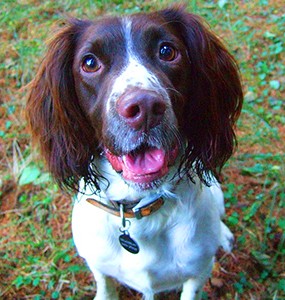Background
The English Springer Spaniel is closely related to the Cocker Spaniel. So close in fact that they were once part of the same litter. Both were born and bred for hunting. Cocker Spaniels were the smallest of the litter and were used to hunt woodcock. The larger, Springer Spaniels, were used to chase game bird from the brush. The name “Springer” stems from the way they “spring” out of the brush.
The English Springer Spaniel is a descendant from the Norfolk or Shropshire Spaniel and was recognized as an independent breed in 1902. The English Springer Spaniel Field Trial Association formed in 1924 and began interbreed competitions. English Spaniels compete both in hunting skills and athletics.
More recently English Springer Spaniels have been used as "sniffing dogs." They have excellent noses and can be used for bomb detection or trained to sniff out contraband in prisons.
Sizing up
- Weight: 40 to 50 lbs
- Size: 19 to 20 inches
- Coat: Short and course
- Colors: Black, liver, white
- Life expectancy: 12-14 years
What's he like?
The English Springer Spaniel is a hunter and a competitor by nature. He excels at sports including flyball, dock diving and tracking. He requires plenty of exercise and should be kept in excellent physical condition. That’s not to imply that the Springer is overactive. With proper exercise he’ll be a calm and polite pet.
The English Springer Spaniel is intelligent, a strong sniffer and great at playing games. We recommend playing the shell game with treats: Hide the treat under whatever shell you choose and then mix it up with two empty shells. Have your Spaniel sniff out the right shell to earn the treat.
The English Springer is friendly and great at meeting new people. He handles children well and is happiest with his family. He'll bark when someone approaches your house as he’s eager to meet them. He could be happy on a ranch or in an apartment so long as it’s with the people he loves.
There’s variation among English Springers. Some might come from a show line and others from a hunting line. Either way, when it comes to this breed, instincts will tell him to hunt and he will give chase to birds and possibly smaller pets. Early training can focus these instincts and help your Spaniel to chase the right things.
As with all breeds some health problems are more likely to occur in Spaniels. These include:
- Hip dysplasia
- Progressive retinal atrophy
- Elbow dysplasia
- Retinal dysplasia
- Ear infections
Right breed for you?
- Exercise: The Spaniel requires daily exercise, more so than some other breeds
- Affectionate: He's a family dog and will suffer if left alone for long periods of time
- Grooming: The Spaniel has a thick coat and needs regular grooming
- Loyal: The Springer will remain loyal to you forever so make sure you can give the same commitment to him.
If you have any questions or concerns, you should always visit or call your veterinarian – they are your best resource to ensure the health and well-being of your pets.
